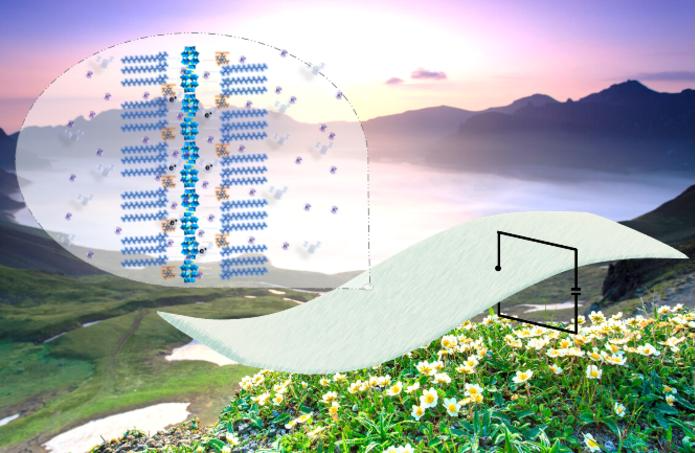Researchers are seeking ways to utilize the low-value energy extensively distributed in natural environments to produce electricity.

The polyoxometalate power generator collects the natural atmospheric humidity and produces continuous electrical signals by the uneven distribution and directional movement of ions, realizing efficient collection and utilization of low-value energy. Image Credit: Nana Research, Tsinghua University Press
A research group has made a power generator that gathers the natural atmospheric humidity and generates constant electrical signals.
This is the first humidity generator that has been developed utilizing a nano-sized material known as polyoxometalates. It holds the ability to be a new research direction for polyoxometalates in the viable utilization of low-value energy.
In the operation of energy conversion devices, the research group set forth to resolve the issue of discontinuity. They sought to fulfill the lack of atmospheric humidity power generation materials and also the restricted performance of materials.
We wanted to understand the conversion process of atmospheric humidity energy to electrical energy and the role of polyoxometalates in the atmospheric humidity power generation.
Weilin Chen, Professor, Department of Chemistry, Northeast Normal University
Polyoxometalates, called POMs, consists of unique morphology and functional properties, which make them highly beneficial in controllable synthesis, assembly, and performance research.
They are an adaptable class of inorganic molecular materials. POM nanomaterials could self-assemble to develop microporous structures that have the potential to collect atmospheric humidity.
Also, they are environmentally friendly and have great heat, light, and chemical stability. Researchers expect that POM nanomaterials are materials with the ability to use atmospheric humidity effectively.
The research group-built POMs into organic ammonium-polyoxoanion clusters. The clusters were arranged into thin film power generators with small, nano-sized pores known as micropores, which have the potential to work in atmospheric humidity.
Their small POM generator produced a voltage of 0.68 V, was stable, and worked constantly under nearly all-natural environments, with atmospheric humidity varying from 10% to 90%.
The POM atmospheric humidity generator functions as the POM nanoclusters voluntarily absorb atmospheric humidity with the micropores in POM nanowires films. They develop a distribution gradient of water which is considered to be the structural basis of power generation. The POM generator has proven to come with high stability and continuous power generation performance.
The team identified the fact that the POM power generator could effectively gather the natural atmospheric humidity and generate constant electrical signals by the directional movement and uneven distribution of ions. This work offers new concepts for the continuous usage of low-value energy and a new research angle for polyoxometalate chemistry.
There has been a pressing need to develop a constant low-value energy in a natural environment. In past research, researchers have created devices that gather and utilize low-value energy.
However, such devices have been restricted since low-value energy is unstable and intermittent. In the past few years, researchers have advanced their use of atmospheric humidity energy. However, the team’s POM generator is the first humidity generator to produce continuous power.
The most important message is that continuous power generation using atmospheric humidity has been achieved through the design and modification of POMs nanomaterials, and the mechanism of atmospheric humidity power generation has been deeply understood by using the characteristics of POMs nanomaterials.
Weilin Chen, Professor, Department of Chemistry, Northeast Normal University
Moving forward, by screening and optimizing materials, the team believes in enhancing the efficiency of atmospheric humidity power generation. It wishes to obtain a deeper insight into the atmospheric humidity power generation process.
The ultimate goal is achieving the efficient use of humidity generators to promote sustainable development of energy and the environment by exploring the mechanism that optimizes the efficiency of the humidity generator.
Weilin Chen, Professor, Department of Chemistry, Northeast Normal University
Journal Reference
Ji, T., et al. (2023) Polyoxometalates for continuous power generation by atmospheric humidity. Nano Research. doi.org/10.1007/s12274-023-5959-5.
Source: http://www.tup.tsinghua.edu.cn/en/index.html